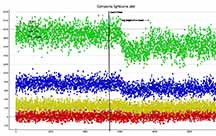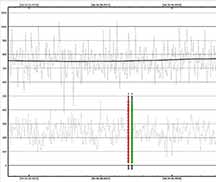

This is a relatively bright event at high altiude=70, Az=90. in Andromeda. The uncertainty range is larger than usual, but the RUWE is solid. Given the rather frequent misses on better ranked events, I don't really know where this one will go. It's worth a try at home. Centerline is through the bike path at UCSC upper meadow, on a near north/south path direction.
 |
 |
Despite the low rank, everyone was on board for trying it, being a weekend before midnight.
I observed from the bike crossing at upper meadow UCSC, on the east side in the south side of the clearing. Target was high overhead but not a problem for clearing the telescope base. However, I did not get a great GoTo position and could not ID the star field, nor would it go to M33 as a check on GoTo accuracy, so I quick did a re-align using Capella and Fomalhaut, and this time it worked OK and I got on target. The target was quite faint in the monitor and I worried I'd have low S/N trouble again, but not to; the high altitude perhaps helped a lot. The light curve was well behaved and I got a very solid 0.400 sec positive. I worried that the fog would get me, and that perhaps I should have driven north of Kirk instead of settling at the bike crossing. Earlier in the evening, when trying to drive up to see the comet, I felt warm dry air above the marine layer at the bike crossing. But now, the air felt cool and damp, and I could see the tops of the fog off in the west, not far below me. Indeed, during the event taping, the air reached saturation and fog began to form. It did not hurt my photometry until it covered the target slightly, about 15 sec after the event.
I set it at 4x, as 2x the target was invisible on the monitor. I used TME apertures on the target and 2 ref stars, which required about 10 minutes of CPU time for PyMovie to complete the task. The light curve looks good, and may even justify re-analysis with Fresnel diffraction, given the visible rise at begin and end of the event. But the ratio of target star to asteroid diameter ratio was not available for the star, but the asteroid was a small 7.17 mas. I did reductions in "square wave" mode.
Kirk and I were about an asteroid width apart, for a very narrow small asteroid, so not surprising that just a couple miles up the road, he had a miss and I had a near maximum solid positive; it doesn't require a strange shaped asteroid.
magDrop report: percentDrop: 100.0 (magDrop cannot be calculated because A
DNR: 3.60
D time: [06:30:41.2134]
D: 0.6800 containment intervals: {+/- 0.0160} seconds
D: 0.9500 containment intervals: {+/- 0.0423} seconds
D: 0.9973 containment intervals: {+/- 0.0820} seconds
R time: [06:30:41.6134]
R: 0.6800 containment intervals: {+/- 0.0160} seconds
R: 0.9500 containment intervals: {+/- 0.0423} seconds
R: 0.9973 containment intervals: {+/- 0.0820} seconds
Duration (R - D): 0.4000 seconds
Duration: 0.6800 containment intervals: {+/- 0.0240} seconds
Duration: 0.9500 containment intervals: {+/- 0.0542} seconds
Duration: 0.9973 containment intervals: {+/- 0.0973} seconds
 |
 |
 |
 |
 |
 |
Observed from "the Berm". Got a recording, looks like a miss. Kirk was a full asteroid radius away from me, in the cross-track direction, so even a circular asteroid on which the centerline passed over me, would give a miss for Kirk. Looks like we pinned this one pretty well, astrometrically. A small SE shift would do it. That is a shift in the direction towards Karl, so his data will help further to give the position of this asteroid.
KB: A miss for me for 2000 YJ135, 4x at the Berm. I don't see any event. I tried static apertures and again with TME. TME results attached. PyOTE detectability test said an event as short as 0.15 sec would be detectable, and max predicted was 0.49 sec.
 |
 |
Looks like a miss. |
Observed from home(?). Not analyzed yet.